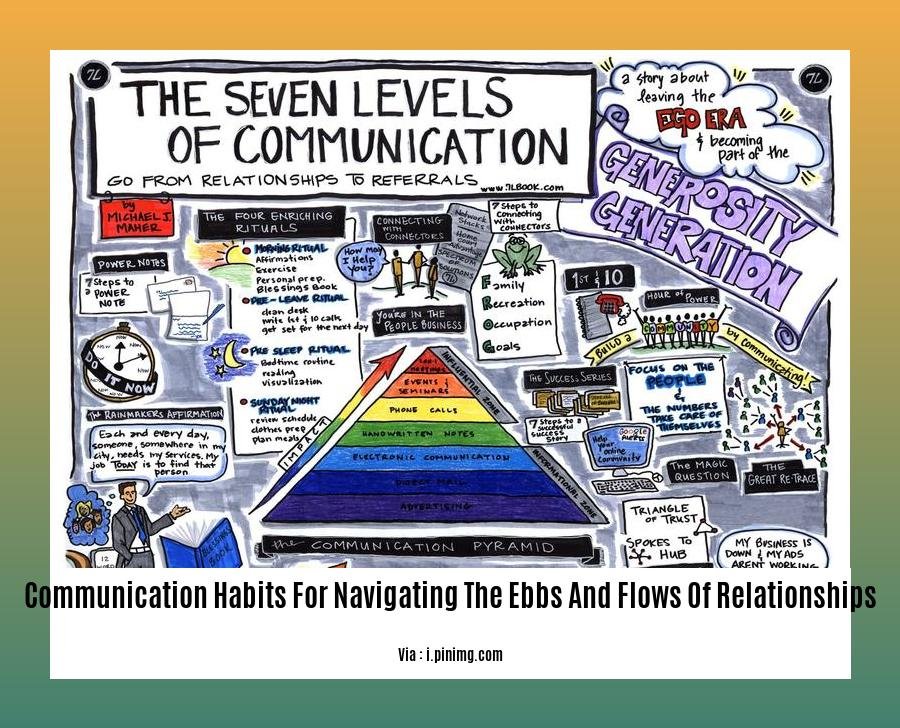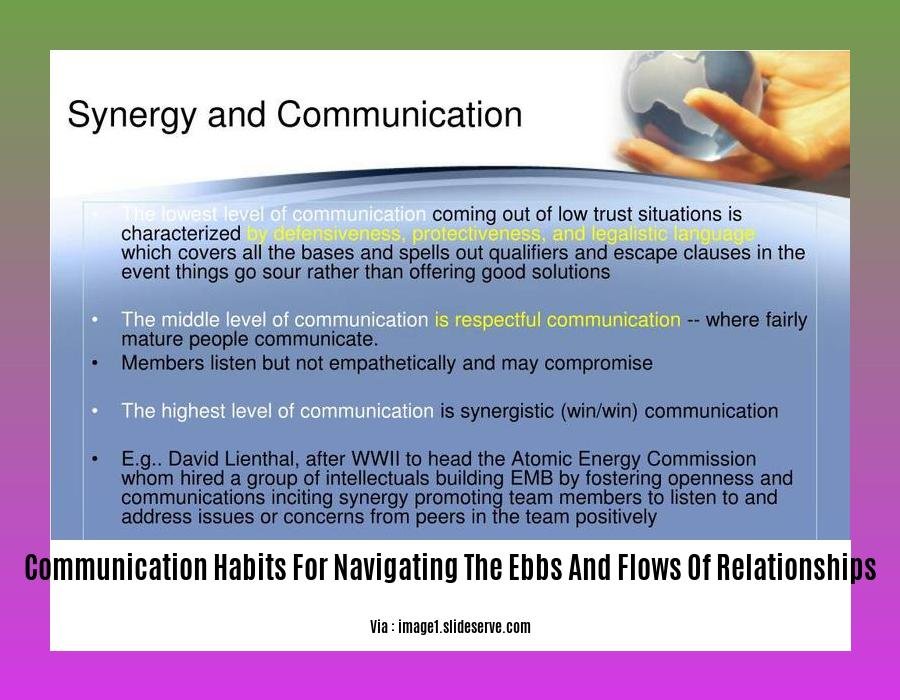Delve into the intricacies of human relationships with our exploration of “Communication Habits for Navigating the Ebbs and Flows of Relationships.” Communication is the lifeblood of any connection; it nurtures bonds, deepens intimacy, and guides couples through life’s inevitable challenges. By understanding and implementing healthy communication habits, individuals can unlock the transformative power of open, respectful, and empathetic dialogue, ultimately cultivating fulfilling and enduring relationships.
Key Takeaways:

- Open and honest communication: Express needs, desires, and concerns in a safe space.
- Embrace desire fluctuations: Recognize that desire naturally changes over time, and avoid negative self-judgments.
- Communicate desire shifts: Discuss changes in desire openly and seek support if necessary.
Communication Habits for Navigating the Ebbs and Flows of Relationships
Open and honest dialogue is the bedrock of healthy relationships. By establishing a safe space for vulnerability and understanding, couples can create a strong foundation for navigating the inevitable ups and downs of life together.
Regular Check-Ins:
Couples should make a habit of checking in with each other about their needs, desires, and concerns. This proactive approach helps prevent misunderstandings and allows both partners to feel heard and supported.
Empathetic Listening:
True communication goes beyond speaking; it involves attentively listening to your partner’s perspective. Practice empathy by trying to understand their feelings and needs, even if you don’t fully agree.
Respectful Disagreements:
Disagreements are a natural part of any relationship. The key is to handle them respectfully. Avoid interrupting, name-calling, or dismissing your partner’s opinions. Instead, focus on finding common ground and understanding each other’s perspectives.
Seek Support:
If you’re struggling to navigate the ebbs and flows of your relationship through communication alone, don’t hesitate to seek support. A therapist or counselor can provide an impartial perspective and facilitate healthy dialogue between partners.
Embrace the Journey:
Relationships are not static; they evolve and change over time. Embrace the journey, with its highs and lows, and focus on building a strong foundation based on open communication. This will help you weather the storms and thrive together through life’s ups and downs.
To ensure healthy communication through the ups and downs of relationships, it’s essential to delve into the secrets of thriving in adversity. Discover how to keep communication strong during trying times, unlocking the key to making your partnership indestructible. Dive into the tips for open dialogue that will help you and your loved one navigate the highs and lows of your journey together effortlessly.
Express Needs and Boundaries
Effective communication is a cornerstone of healthy and fulfilling relationships. Expressing needs and boundaries is a vital aspect of this communication, enabling individuals to navigate the ebbs and flows of relationships effectively.
Key Takeaways:
- Assertively expressing needs ensures that your partner understands and can meet them, fostering a sense of validation and appreciation.
- Openly communicating boundaries establishes clear limits, preventing resentment and misunderstandings.
- Active listening and empathy promote mutual respect and understanding, creating a safe space for expressing needs and boundaries.
- Healthy boundary setting protects your physical, emotional, and psychological well-being, fostering self-esteem and preventing unhealthy relationships.
- Expressing needs and setting boundaries is an ongoing process that requires open communication and a commitment to fostering a healthy and respectful relationship.
Strategies for Expressing Needs and Boundaries:
- Choose the right moment: Pick a time when both partners are calm and have ample time for discussion.
- Be clear and direct: State your needs and boundaries without ambiguity.
- Use “I” statements: This helps express your feelings and needs without blaming or accusing your partner.
- Respect your partner’s boundaries: Listen attentively to their needs and boundaries and be willing to compromise when possible.
- Be willing to negotiate: Healthy relationships involve finding mutually acceptable solutions that respect both partners’ needs and boundaries.
Most Relevant URL Source:
- Communication and Boundaries
Navigate Conflict Constructively
Engage in authentic communication by setting intentions before conversations. Pay attention to physical signals during conflicts and practice deep breathing to calm down.
Provide undivided attention to your partner and listen with compassion. Practice empathetic listening by considering perspectives and emotions. Establish a safe space for everyone to feel heard and respected.
Communicate assertively to express feelings and concerns clearly. Use “I” statements and avoid blaming language. Focus on finding solutions together rather than dwelling on the problem. Remember, disagreements are opportunities for growth.
Key Takeaways:
- Set intentions for authentic communication.
- Calm down in the midst of conflicts through deep breathing.
- Listen actively and with compassion.
- Create a safe space for respectful communication.
- Express feelings and concerns assertively using “I” statements.
- Focus on finding solutions together.
- Embrace conflicts as opportunities for growth.
Most Relevant URL Source:
Foster Open and Respectful Dialogue
Key Takeaways:
- Practice attentive listening and encourage open expression of thoughts and emotions.
- Welcome and value diverse perspectives, creating an environment where everyone feels heard and respected.
-
Set clear expectations and boundaries to facilitate respectful and productive dialogue.
-
Acknowledge and validate emotions.
When someone is sharing their feelings, show that you’re listening and that you understand what they’re going through. Use phrases like, “I understand why you’re feeling that way,” or “I can see how that would make you upset.”
- Use “I” statements.
When you’re expressing your own feelings, use “I” statements instead of “you” statements. This will help you to take ownership of your feelings and to avoid blaming the other person. For example, instead of saying “You always make me feel bad,” you could say “I feel bad when you say things like that.”
- Avoid interrupting.
When someone is speaking, let them finish before you start talking. Interrupting can be disrespectful and it can make the other person feel like you’re not listening to them.
- Be mindful of your body language.
Your body language can communicate a lot about how you’re feeling. Make sure that your body language is open and inviting, and that you’re not crossing your arms or legs, or looking away.
- Take breaks if you need them.
If you’re feeling overwhelmed or frustrated, it’s okay to take a break from the conversation. Let the other person know that you need a few minutes to calm down, and then come back to the conversation when you’re ready.
- Remember that it’s okay to disagree.
You don’t have to agree with everything the other person says, but it’s important to be respectful of their opinions. If you do disagree, try to do so in a way that is respectful and open-minded.
- Don’t be afraid to apologize if you make a mistake.
We all make mistakes, and it’s important to apologize if you say something that you regret. Apologizing shows that you’re willing to take responsibility for your actions and that you’re committed to maintaining a healthy relationship.
Most Relevant URL Source:
- HBR: How to Communicate Difficult News with Empathy and Grace











